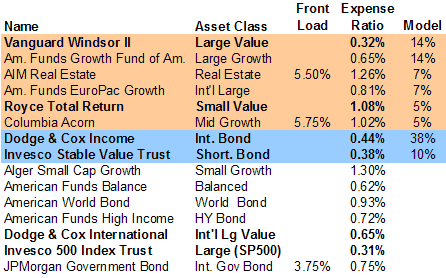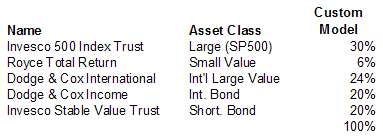My mom has been asking me to look over her 401k plan, as she has been worried about its performance and suitability recently. In fact, she changed all the future contributions to 100% bonds a while back. As her 401(k) had somewhat limited choices (although they could definitely be worse), I had to make do with what was available. Usual disclaimer applies: I am not a financial professional.
1. Decide on an asset allocation.
This can be a complex topic, but I put most of my research in this series of posts on asset allocation. Given my mom’s age, years until retirement, other existing investments, and and risk preferences, I recommended an overall asset allocation of 60% stocks and 40% bonds. Currently, she is at 68%/32%. I would definitely like to have at least a broad US stock fund, a broad international stock fund, and a broad US bond fund. It might be nice to have Large-cap Value, Small-cap Value, Emerging Markets, Real Estate, or Inflation-protected Bond funds. The final ratios will be similar to the asset allocation breakdown here.
2. Make a list of fund options and characteristics
First up, you’ll want to gather a list of all your available investment options. Usually this includes about 5-30 mutual funds. If the fund details are not well organized, just ask for the ticker symbol and pull up their Morningstar.com snapshot. Put them in a spreadsheet, and include the each fund’s asset class, any front- or back-end loads, and annual expense ratio. Here are the 15 options in my mom’s 401(k) plan:

Now, I am completely ignoring Morningstar “star” ratings. They are based primarily on past recent performance, which have been shown to be a poor indicator of future long-term performance. You could buy a 5-star fund and have it end up a 1-star fund a few years later. Fund managers change all the time as well. I want to create a low maintenance portfolio that doesn’t involve chasing hot managers or performance.
3. Narrow down the options by cost and asset class.
If I don’t need the asset class, then I cross it out. If there are two similar funds, then pick the cheaper one with lower loads. In my “nice to have list”, if it is too expensive, then it becomes less useful as a diversifier and I cross it out as well. An example is the AIM Real Estate fund, with the 5.5% front load. The 6 bolded funds above are the ones that I am left with.
4. Decide if you are going to do a full asset allocation or cherry pick
It is often recommended that you implement your asset allocation across all your investment accounts (401ks, IRAs, brokerage) as one pie. For example, you might hold all your bond funds in tax-sheltered accounts for optimal tax efficiency. Or your 401k might only have one really good fund, and you can buy the other asset classes elsewhere. If this is the case, then you might want to cherry pick the funds you want for your 401k.
For other reasons, you might just want to implement your entire asset allocation as best you can within the 401k. I’m going to go ahead with this latter route for now.
5. Consider Target-date Funds or Pre-Set Model Portfolios
Many 401(k)s include an even simpler option, either all-in-one Target-dated funds or pre-set portfolio mixes. But all target-date funds are not made the same. Look at the prospectus and see what funds are included within them, and if they charge you an extra layer of management fees on top of the fees of the underlying funds. Many are crap, and you could do much better with your own custom mix. My mom’s 401k has no such option.
She does however, have a few options for pre-set model portfolios. These are basically a set ratio of selected funds (the pink and blue highlighted items above), which are are automatically rebalanced once a year. Shown above is the breakdown the “balanced model” option. However, I don’t like them because they include several expensive funds and exclude some of what I think are the best funds. Not including the large front-end loads of two of the funds, the average weighted expense ratio of the model portfolio was 0.59%.
6. Construct Your Custom Portfolio
In the end, I chose the 5 funds below. I decided to leave out Windsor II (Large Value fund) for the sake of simplicity. I calculated the averaged weighted expense ratio to be 0.48%.

7. Explain and Implement
Now, I have to explain to my mom why I picked these funds, and how they may perform in the future. If she wants, I may shift it to 50% stocks/50% bonds. I’ll check in on it again after a year to show her how to rebalance. This is not the perfect portfolio, but it will be better than her previous hodgepodge, and also be easier to manage.
 The Best Credit Card Bonus Offers – 2025
The Best Credit Card Bonus Offers – 2025 Big List of Free Stocks from Brokerage Apps
Big List of Free Stocks from Brokerage Apps Best Interest Rates on Cash - 2025
Best Interest Rates on Cash - 2025 Free Credit Scores x 3 + Free Credit Monitoring
Free Credit Scores x 3 + Free Credit Monitoring Best No Fee 0% APR Balance Transfer Offers
Best No Fee 0% APR Balance Transfer Offers Little-Known Cellular Data Plans That Can Save Big Money
Little-Known Cellular Data Plans That Can Save Big Money How To Haggle Your Cable or Direct TV Bill
How To Haggle Your Cable or Direct TV Bill Big List of Free Consumer Data Reports (Credit, Rent, Work)
Big List of Free Consumer Data Reports (Credit, Rent, Work)
New to the 401K market, when it is implemented, do you specify the allocation per fund and then just send money to the investment company and they divide the money up by the % per fund of your choosing?
In my experience, yes, that is how it works for contributions. For example, if you set it to 40% Fund A and 60% Fund B, then for each $100 in contributions deducted from your paycheck $40 will go into Fund A and $60 into Fund B.
There is also an option to move money between funds for your existing balance, as the ratios will change due to each fund’s individual market performance.
How about index funds for people? Might not sound as glamorous but not a bad way to invest.
You mentioned checking back in about a year to rebalance. Do you recommend rebalancing once a year? From my reading it has been recommended to rebalance once every two or three years. Thoughts anyone?
This post would be much more interesting if you showed what she had before the 401k make over.
Can you add her holdings?
I like the balance of the assets you chose for your mother. Diversity is the key here.
You sure know a lot for someone who isn’t a financial planner.
Mark – As noted, the index fund available in her 401k was the S&P 500 Index trust. Many people have very limited access to low-cost index funds in their 401k.
Start-Up – I’ve read varying stuff, from rebalancing as often as possible to “letting things run” and doing it every few years. I think once a year is a reasonable compromise.
Ted – Her previous holdings were similar to the model portfolio mentioned, but slightly more stocks. It was the same funds that were highlighted above. I think she used to go with the model, and then started doing some stuff on her own recently with new contributionns. I left it out for simplicity, as I was more interested in documenting the process.
Interesting funds: two of them are actually ones that I had in my old 401k plan. Im lucky enough now to have a great index fund that I put most of my money in. The expense ratio is about .10 if I remember right…most people are not so fortunate.
Very well researched. Thanks for the practical example!
In regards to loads, most 401ks waive the front load on the fund. You need to make sure to verify this with the administrator, and often (as in your mom’s case) the expenses are still high. But that at least may give another now “no-load” option to choose from. I know in my previous 401k, I had access to a couple of American Funds w/ no load. They weren’t great, but they were the best choices I had for at least one asset class.
Not directly related to this article but I left a company earlier this year in which I had both 401k and Roth 401k contributions. Should I roll those over into existing IRA and Roth IRA accounts or is there some reason that I need to avoid co-mingling the funds and open new accounts?
Troy – I think you should be able to roll them over. However, once you roll them over you won’t be able to move them again (say, to your next 401k). Also, if there are a mix of pre-tax and after-money in the Traditional, it can get a little messy if you want to to a Trad-to-Roth rollover later on.
Thanks but I probably didn’t make myself clear. I know that I can roll over my accounts and that the pre-tax 401k and post-tax Roth 401k need to be remain separated. What I’m not sure of is whether my roll over pre-tax funds/holdings can go into an existing Traditional IRA account, and the same for the Roth 401k into an existing Roth IRA. In other words, does the fact that an IRA account was funded by a direct contribution need to be maintained separately from an IRA that was funded through 401k contributions? Same for Roth 401k and Roth IRA. So far I’ve kept everything separated but I’m not sure if I really need more than 2 accounts (one Traditional IRA and one Roth IRA). I have the following separate accounts:
1) IRA – direct contributions
2) IRA – 401k rollover Job A
3) IRA – 401k rollover Job B
4) Roth IRA – direct contributions
5) Roth IRA – converted Traditional IRA (taxes paid over 4 years when it first came out)
6) Roth IRA – rollover from Roth 401k
Is there any reason I shouldn’t consolidate the traditional IRAs and Roth IRAs? Once I do it, it can’t be undone so I’m being very cautious about this.
Thanks for this great post! Right now I just have a Roth IRA, but I think many of these points still apply. And my husband will soon have a real job (and not a graduate assistantship), so we will probably be looking into a 401k then.